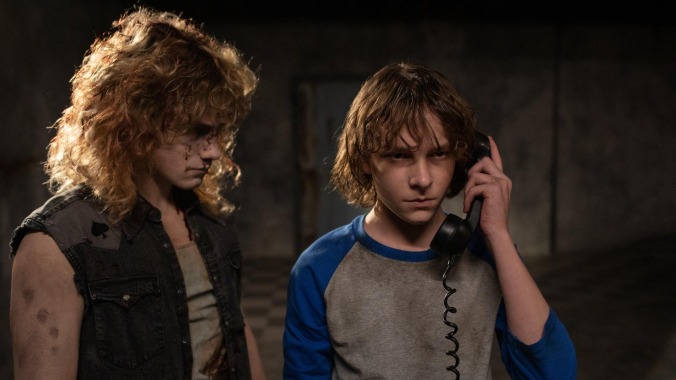The Black Phone dials a wrong number
Adaptation of Joe Hill's short story doesn't scare up many chills, despite Ethan Hawke's best efforts

Based on a short story by Joe Hill, The Black Phone hits a sweet spot regarding its subject matter, its setting, its tone, and its star that should allow it to resonate with both hard-core horror fans and casual viewers—“the Conjuring crowd,” so to speak, that comes out only occasionally and under circumstances like these to be terrified in a theater. Like A Nightmare On Elm Street, it focuses on a child kidnapper (and eventually, a killer). Like Stranger Things, it takes place in the not-so-distant past, and reimagines that era according to the cinematic nostalgia of the filmmakers (in this case, director Scott Derrickson and screenwriter C. Robert Cargill), from old Stephen King adaptations to the adolescent meanness of The Bad News Bears. And like the Derrickson and Cargill’s beloved Sinister, it stars Ethan Hawke.
Unfortunately, Hill’s short story does not make for an especially good film—or this adaptation doesn’t make a good one out of it, anyway. When he wasn’t helming Doctor Strange or the remake of The Day The Earth Stood Still, Derrickson developed a pedigree for creating handsome, unsettling images, not only in Sinister but The Exorcism Of Emily Rose. He does so again here, but fails to connect the important dots—or at least answer some vital questions—that would make this serial killer/ghost story truly haunting.
Set in 1978, the film stars Mason Thames as Finney Shaw, a kid who gets bullied at school by his classmates and bullied at home by his abusive father (Jeremy Davies). This despite a tough little sister Gwen (Madeleine McGraw) who stands up for him on the playground, and a pitching arm that even the other team calls “mint.” But when Finney is abducted by a serial killer dubbed “The Grabber” by locals, he’s forced to summon strength he didn’t know he had to find a way to escape.
Locked in a threadbare basement outfitted only with a mysterious telephone whose cord is cut, Finney is understandably skeptical when that phone unexpectedly rings. But when the voice on the other end turns out to be one of the Grabber’s previous victims, he listens in the hope of gleaning advice to help him avoid certain death. In the meantime, Gwen cultivates a Shining-like ability to communicate with the spirits of those same victims, which she uses to try and find Finney when the local police run out of tangible leads.
There are, of course, more complications and complexities to the story that Cargill and Derrickson tell, but we’ll leave them for you to discover. Part of the problem is with the way they tell the story, where these elements overlap but don’t all connect effectively. First of all, it never seems clear exactly what The Grabber wants, or why he doesn’t just kill Finney outright. Mind you, other than murdering horny teenagers, Jason Voorhees’ motive was a one-dimensional pathology, and Michael Myers was simply “pure evil.” Notwithstanding The Grabber’s elision of being a “child murderer” but not a child molester, a cannibal, etc., the question is, what is his goal with this kid, since he isn’t murdering him immediately? He seems to keep Finney around for a long time for no purpose other than to have the boy to experience a coming-of-age moment.
More logistically, Derrickson whiffs on the opportunity to explore the physical space in which Finney is trapped. Instead he relies upon spooky but often meaningless imagery to rachet up tension that should escalate because of the urgency of his (hopeful) escape. The most egregious example of this revolves around a barricaded window that Finney at one point manages to unseal. Although The Grabber enters and leaves the room several times after that point, Derrickson never shows the window again, so it’s unclear whether this dangerous breach of his basement prison is ever detected by the fastidious and obviously thoughtful murderer. But the nightmarish visions, and the broken Coke bottles and other props that Finney uses at his ghostly predecessors’ suggestions, accumulate without building to something that achieves an overall meaning, much less lasting effect.
Hidden behind a modular mask that suggests a bespectacled and smiling Guy Fawkes, Hawke does his best to breathe menace into The Grabber. But without a sense of purpose to make his abductions into terrifying gauntlets, there’s nothing uniquely frightening about him as a villain. Part of the problem might be that young Mason Thames just doesn’t seem consistently frightened enough. Meanwhile, you can’t help but feel sorry for Jeremy Davies as Finney and Gwen’s abusive dad. It’s the kind of role he depressingly excels at, but this film doesn’t allow it enough depth for the character’s moments of tenderness or regret to mitigate the mistreatment of his children.
Ultimately, Cargill and Derrickson lay down tracks for two different provocative ideas—a masked serial killer and a family that unwittingly can communicate with the killer’s victims. But those concepts, much like the film’s needle-drop soundtrack and 1970s period re-creation (down to some racist and homophobic slurs), never tie together into a cohesive story. Which is surprising, because The Grabber is exactly the kind of urban legend that would strike terror into junior high kids, and to make a movie set in an era when that legend would be shared with feverish excitement by kids worried they might become the killer’s next victim (and with no internet to consult) seems like a home run in the making.
Answer the call of The Black Phone if you dare. Just be aware that, much like the severed cord dangling underneath the device, there’s a crucial disconnect between the provocative ideas that it sets up, and what it ultimately delivers.